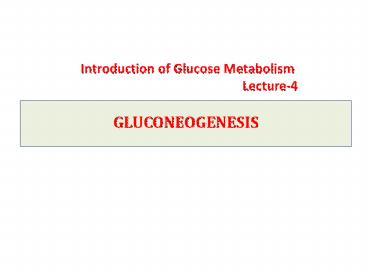Introduction of Glucose Metabolism Lecture-4 - PowerPoint PPT Presentation
Title:
Introduction of Glucose Metabolism Lecture-4
Description:
Introduction of Glucose Metabolism Lecture-4 GLUCONEOGENESIS GLUCONEOGENESIS Gluconeogenesis is the synthesis of glucose from glucogenic precursors which are not ... – PowerPoint PPT presentation
Number of Views:194
Avg rating:3.0/5.0
Title: Introduction of Glucose Metabolism Lecture-4
1
Introduction of Glucose Metabolism Lecture-4
GLUCONEOGENESIS
2
GLUCONEOGENESIS
- Gluconeogenesis is the synthesis of glucose from
glucogenic precursors - which are not of carbohydrate origin
(gluconeogenic precursors) - It occurs during prolonged fasting to synthesize
glucose for tissues - requiring continuous supply of glucose as a
source of energy - Brain, RBCs, Kidney medulla, Lens, Cornea,
Testes, sk.ms - Gluconeogenesis occurs ONLY in the liver
kidneys
3
Gluconeogenesis An Overview
- Both mitochondria and Cytosol
- Exception Glycerol, only cytosol
- Gluconeogenic substrates
- Glycerol
- Lactate and Pyruvate
- Glucogenic amino acids
4
Gluconeogenesis Pathway
Dephosphorylation of G-6-P
Dephosphorylation of F 1,6-P
Transport of OAA
Carboxylation of pyruvate
5
Gluconeogenic precursors
- 1- Intermediates of glycolysis
- by reverse of steps of glycolysis (except 4
steps that need 4 different enzymes) - 2- Intermediates of citric acid cycle
- are converted to oxalacetate then to
glucose - 3- Lactate
- Lactic acid formed of anaerobic glycolysis
in cells as RBCs skeletal muscles - are transported in blood to liver to be
converted to pyruvate then to glucose (Cori
cycle) - 4- Glycerol
- Glycerol is derived from the lipid
triacylglycerol in adipose tissue. - Glycerol is converted into
dihydroxyacetone phosphate (intermediate of - glycolysis) then to glucose.
- 5- Glucogenic amino acids of proteins
- Glucogenic amino acids are deaminated to
form a-ketoacids - a-keto acids are converted to pyruvate or
intermediates of citric acid cycle then to
glucose
6
GLUCOSE
Triacylglycerol in adipose tissue
Precursors of Gluconeogenesis
Fatty acids
Gluconeogenesis
Glycerol
Lactate
Pyruvate
Oxalacetate
Intermediate of CITRIC ACID CYCLE
Glucogenic amino acids in proteins as sk. ms.
7
Glycerol as agluconeogenic Substrate
Glycerol Kinase
Glycerol
Glycerol 3-phosphate
ATP
ADP
NAD
Glycerol 3-phosphate dehydrogenase
NADH
Dihydroxyacetone phosphate
Glucose
GK Glycerol kinase only in liver kidneys
8
Glucogenic Amino Acids
Glycine, Alanine
Amino acids
Pyruvate
Aspartate Aspargine
Glutamate Glutamine
Amino acids
Phenylalanine Tyrosine
Methionine Valine
9
Cori Cycle
Lactate is a gluconeogenic precursor
10
Gluconeogenesis Pathway
Dephosphorylation of G-6-P
Dephosphorylation of F 1,6-P
Transport of OAA
Carboxylation of pyruvate
11
Pruvate Carboxylase and PEP-CK
Pyruvate carboxylase PEP-CK Pyruvate kinase
12
Fructose 1,6-Bisphosphatase
Fructose 1,6-bisphosphatase PFK-1
13
Glucose 6-Phosphatase
Glucose 6-phosphatase Glucokinase
14
GluconeogensisE- Consumed
Six High-Energy Phosphate Bonds From Pyruvate
to Glucose
2 ADP
2 ATP
15
Gluconeogenesis Regulation
- Reciprocal control
- Gluconeogenesis Glycolysis
- Allosteric
- Acetyl CoA (Pyruvate carboxylase)
- Glucagon (I/G ratio)
- Induction (PEP-CK)
16
Unique enzymes of gluconeogenesis
Reactions 1, 2, 3 4 are catalyzed by enzymes
NOT used in glycolysis
GLUCOSE
1- Pyruvate to oxalacatate by pyruvate
carboxylase 2- oxalacetate to phosphoenol
pyruvate by PEP carboxykinase 3- Fructose
1,6 bisphosphate to fructose 6 phosphate by
fructose 1,6 bisphosphatase 4- Glucose
6-phosphate to glucose by glucose
6-phosphatase
GLUCONEOGENESIS
Other reactions of gluconeogenesis are catalyzed
by same enzymes of glycolysis in the reverse
direction































